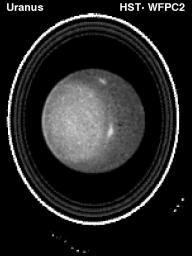This NASA Hubble Space Telescope image of the planet Uranus reveals the planet's rings and bright clouds and a high altitude haze above the planet's south pole.
Hubble's new view was obtained on August 14, 1994, when Uranus was 1.7 billion miles (2.8 billion kilometers) from Earth. These details, as imaged by the Wide Field Planetary Camera 2, were only previously seen by the Voyager 2 spacecraft, which flew by Uranus in 1986. Since then, none of these inner satellites has been further observed, and detailed observations of the rings have not been possible.
Though Uranus' rings were discovered indirectly in 1977 (through stellar occultation observations), they have never before been seen in visible light through a ground-based telescope.
Hubble resolves several of Uranus' rings, including the outermost Epsilon ring. The planet has a total of 11 concentric rings of dark dust. Uranus is tipped such that its rotation axis lies in the plane of its orbit, so the rings appear nearly face-on.
Three of Uranus' inner moons each appear as a string of three dots at the bottom of the picture. This is because the picture is a composite of three images, taken about six minutes apart, and then combined to show the moons' orbital motions. The satellites are, from left to right, Cressida, Juliet, and Portia. The moons move much more rapidly than our own Moon does as it moves around the Earth, so they noticeably change position over only a few minutes.
One of the four gas giant planets of our solar system, Uranus is largely featureless. HST does resolve a high altitude haze which appears as a bright "cap" above the planet's south pole, along with clouds at southern latitudes (similar structures were observed by Voyager). Unlike Earth, Uranus' south pole points toward the Sun during part of the planet's 84-year orbit. Thanks to its high resolution and ability to make observations over many years, Hubble can follow seasonal changes in Uranus's atmosphere, which should be unusual given the planet's large tilt.
The Wide Field/Planetary Camera 2 was developed by the Jet Propulsion Laboratory and managed by the Goddard Space Flight Center for NASA's Office of Space Science.
This image and other images and data received from the Hubble Space Telescope are posted on the World Wide Web on the Space Telescope Science Institute home page at URL http://oposite.stsci.edu/.

 Planetary Data System
Planetary Data System












